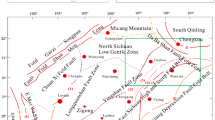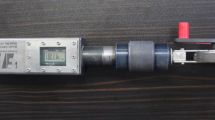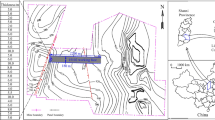Abstract
Acoustic emission and hydraulic fracturing are the direct methods for measuring the in situ stress of rock samples in the laboratory. The acoustic emission experiment (Kaiser effect experiment) is the most widely adopted technique which utilizes the Kaiser effect of rocks, in evaluating the in situ stress of core samples. However, during the Kaiser effect experiment, different loading rates exhibit a certain influence on core samples with varying lithology, and to the best of our knowledge, no scholar had critically addressed this issue. In this study, we performed Kaiser effect experiments on rock samples of different lithologies taken from six case study wells in Jidong Nanpu Oilfield, China. Then, we obtained curves showing the relationship between the stress corresponding to the Kaiser effect of limestone, sandstone, gritstone, and mudstone at different confining pressures. Based on the curves, the true values of the in situ stress were determined. The accuracy of the estimated stress from the acoustic emission experiment was validated via a comparative analysis of the in situ stress from the hydraulic fracturing method. The findings revealed that, for sandstone, gritstone, and mudstone, the stress corresponding to the Kaiser effect spots significantly increased with the loading rate, while for brittle rocks such as limestone, the loading rates had a minimal impact on the Kaiser effect. It is recommended to use an optimal loading rate for a better result during a Kaiser effect experiment. This study provides a reliable basis for the experimental evaluation of in situ stress that is relevant Oilfields and mining development projects.





Similar content being viewed by others
Abbreviations
- MTS:
-
Mechanical testing and simulation
- SAMOS™:
-
Sensor-based Acoustic Multi-channel Operation Systems
- PAC:
-
Physical Acoustics Corporation
- PCI:
-
Peripheral Component Interconnect
- AE:
-
Acoustic emission
- σ v :
-
Overlying strata stress
- σ H :
-
Maximum horizontal principal stress
- σ h :
-
Minimum horizontal principal stress
- P p :
-
Formation pore pressure
- α :
-
Effective stress coefficient
- σ ⊥ :
-
Kaiser point stress of vertical core
- \( {\boldsymbol{\sigma}}_{{\mathbf{0}}^{\boldsymbol{o}}} \) :
-
Kaiser point stress of 0o horizontal core
- \( {\boldsymbol{\sigma}}_{{\mathbf{45}}^{\boldsymbol{o}}} \) :
-
Kaiser point stress of 45o horizontal core
- \( {\boldsymbol{\sigma}}_{{\mathbf{90}}^{\boldsymbol{o}}} \) :
-
Kaiser point stress of 90o horizontal core
- θ :
-
Angle between 0o the horizontal core and maximum horizontal principal stress
- S t :
-
Tensile strength
- P f :
-
Formation fracture pressure
- P r :
-
Reopening pressure
- P s :
-
Instantaneous shut-in pressure
References
Aslannazhad M, Khaksar AM, Jalalifar H (2016) Determination of a safe mud window and analysis of wellbore stability to minimize drilling challenges and non-productive time. J Pet Explor Prod Technol 6:493–503. https://doi.org/10.1007/s13202-015-0198-2
Bloch M, Siqueira CAM, Ferreira FH, Conceicao JCJ (1997) Techniques for determining in situ stress direction and magnitudes. Soc Pet Eng. https://doi.org/10.2118/39075-MS
Cai MF, Qiao L (1995) The theory and techniques of crustal stress measurement. Science Press, Beijing, China
Chang CD, Mark DZ, Abbas K (2006) Empirical relation between rock strength and physical properties in sedimentary rocks. J Pet Sci Eng 51(3/4):223–237
Christiansson R, Martin CD (2004) Quantifying in situ stress and its role in repository design. American Rock Mechanics Association.
Fa L, Zeng Z, Liu H (2010) A new device for measuring in situ stresses by using acoustic emissions in rocks. American Rock Mechanics Association.
Feng J, Shang L, Li X, Luo P (2019) 3D numerical simulation of heterogeneous in situ stress field in low-permeability reservoirs. Pet Sci 16:939–955. https://doi.org/10.1007/s12182-019-00360-w
Ghassemi A (2012) A review of rock mechanics issues in geothermal reservoir development. Geotech Geol Eng 30:647–664. https://doi.org/10.1007/s10706-012-9508-3
Gong ZS (1997) Giant offshore oil and gas fields in China. Petroleum Industry Press, Beijing (in Chinese)
Goodman RE (1963) Subaudible noise during compression of rocks (1963) The. Geol Soc Am Bull 74(4):487–490
He J, Okere CJ, Su G, Hu P, Zhang L, Xiong W, Li Z (2021) Formation damage mitigation mechanism for coalbed methane wells via refracturing with fuzzy-ball fluid as temporary blocking agents, Journal of Natural Gas Science and Engineering. Vol. 90:103956. https://doi.org/10.1016/j.jngse.2021.103956
Hou B, Chen M, Jin Y, Diao C, Lin B, Lu Y (2015) Prediction method of in situ stress in non-isopachous ultra-deep composite salt-gypsum formation. Soc Pet Eng. https://doi.org/10.2118/176325-MS
Hou-tian H (2006) Experimental research on measurement of in situ stress field by Kaiser Effect. Chin J Rock Mech Eng.
Hudson JA, Cornet FH, Christiansson R (2003) ISRM suggested methods for rock stress estimation—part 1: strategy for rock stress estimation. Int J Rock Mech Min Sci 40(7-8):991–998
Kanagawa T, Nakasa H (1978) Method of estimating ground pressure, 4107981.
Kang Z, Gu S, Yan Y, Zhou K, Qiang L, Zhu S (2018) A simple and accurate interpretation method of in situ stress measurement based on rock kaiser effect and its application. Geofluids 1-13
Kolawole O, Ispas I (2020) Interaction between hydraulic fractures and natural fractures: current status and prospective directions. J Pet Explor Prod Technol 10:1613–1634. https://doi.org/10.1007/s13202-019-00778-3
Kramadibrata S, Simangunsong G, Matsui K, Shimada H (2011) Role of acoustic emission for solving rock engineering problems in Indonesian underground mining. Rock Mech Rock Eng 44:281–289
Kun D, Xuefeng L, Ming T, Shaofeng W (2020) Experimental study on acoustic emission (AE) characteristics and crack classification during rock fracture in several basic lab tests. Int J Rock Mech Min Sci 133:104411. https://doi.org/10.1016/j.ijrmms.2020.104411
Lavrov A (2001) Kaiser effect observation in brittle rock cyclically loaded with different loading rates. Mechanics of Materials, 33(11):669–677.
Li Y, Schmitt DR (1997) Effects of Poisson’s ratio and core stub length on bottom hole stress concentration. Int J Rock Mech Min Sci Geomech Abstr 34(5):761–773
Lu Y, Chen M, Jin Y, Wu W, Zhang J, Li Y (2011) A new method for determination of geographic orientation of deep formation geostress. Chin J Rock Mech Eng 30(2):233–237
Meng XG et al (2016) Acoustic emission ground stress field testing and mechanism of deformation and instability in deep soft rock roadway. J China Coal Soc 41(5):1078–1086
Nikkhah M, Ahmadi M, Ghazvinian A (2011) Application of pattern recognition analysis of rock acoustic emission for determination of Kaiser effect. Proceedings of 12th ISRM Congress, China, 765-769.
Okere CJ, Su G, Zheng L, Cai Y, Li Z, Liu H (2020) Experimental, algorithmic, and theoretical analyses for selecting an optimal laboratory method to evaluate working fluid damage in coal bed methane reservoirs. Fuel 282:118513. https://doi.org/10.1016/j.fuel.2020.118513
Paneiro G, Dinis da Gama C (2014) Applicability of acoustic emission technique for vertical stress determination in mine pillars. Proceedings of ISRM Regional Symposium. Spain: (2014), 273-278.
Qingbin M, Chen Y, Zhang M, Han L, Pu H, Liu J (2019) On the Kaiser effect of rock under cyclic loading and unloading conditions: insights from acoustic emission monitoring. Energies 12(17):1–18
Saeidi A, Shahriyar H, Sandra L, Rouleau A (2021) The effects of in situ stress uncertainties on the assessment of open stope stability: case study at the Niobec Mine, Quebec (Canada). Geomech Energy Environ 25:100194
Seto M, Nag DK, Vutukuri YS (1996) Experimental verification of the kaiser effect in rock under different environment conditions. Int Soc Rock Mech Rock Eng.
Seto M, Utagawa M, Katsuyama K (1995) The relation between the variation of AE hypocenters and the Kaiser effect of Shirahama sandstone. Int Soc Rock Mech Rock Eng
Toksarov V, Asanov V, Evseev A, Beltukov N, Udartsev A (2016) Sedimentary rock stress determination in boreholes using kaiser effect. Int Soc Rock Mech Rock Eng
Utagawa M, Seto M, Katsuyama K (1995) Application of acoustic emission technique to determination of in situ stressess in mines. Proc. 26th Int. Conf. Safety in Mines Research Institute Vol. 4, Central Mining Institute, Katowice, Poland, pp. 95-109.
Yan-xing L (2009) In situ Int Soc Rock Mech Rock Engock. Chin J Rock Mech Eng
Yong-dong J (2005) Research on in situ stress measurement and rockburst forecast in tunnels.
Yoshikawa S, Mogi K (1989) Experimental studies on the effect of stress history on acoustic emisión activity-a possibility for estimation of rock stress. J Acoustic Emisión 8(4):113–123
Zang A, Stephansson O (2009) Stress field of the earth’s crust. Berlin: Springer; p 131–192.
Zhang G, Jin Y, Chen M (2002) Measure in situ stress by Kaiser effect in the compress. Chinese Journal of Rock Mechanics and. Engineering 21(3):360–363
Zhang R, Xie H (2006) Experimental study on acoustic emission characteristics of rock failure under uniaxial multilevel loadings. Chin J Rock Mech Eng. 25(12), 584–2 588.
Zhang Y, Wang G, Jiang Y, Wang S, Zhao H, Jing W (2017) Acoustic emission characteristics and failure mechanism of fractured rock under different loading rates. Shock Vib:2017
Acknowledgements
The authors would like to thank PetroChina Innovation Foundation (Grant No. 2017D50070313), Major National Special Projects (Grant No. 2016ZX05061-009) for the financial support, and the Key Laboratory of Petroleum Resources and Prospecting, China University of Petroleum, China (Grant No. PRP/open-1706). Chinedu J. Okere appreciates the scholarship from the China Scholarship Council (2019ZFY020452). The authors thank Prof. Mian Chen Mian, Prof. Yan Jin and Liangchuan Li for their profound contribution.
Author information
Authors and Affiliations
Corresponding author
Additional information
Responsible Editor: Zeynal Abiddin Erguler
Rights and permissions
About this article
Cite this article
Zhang, Y., Okere, C.J. & Su, G. Effect of loading rates on accurate in-situ stress determination in different lithologies via Kaiser effect. Arab J Geosci 14, 1304 (2021). https://doi.org/10.1007/s12517-021-07674-3
Received:
Accepted:
Published:
DOI: https://doi.org/10.1007/s12517-021-07674-3




